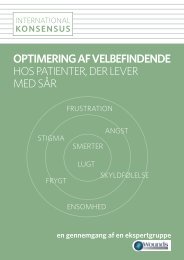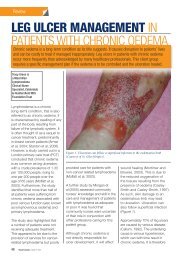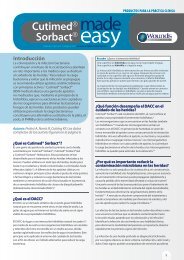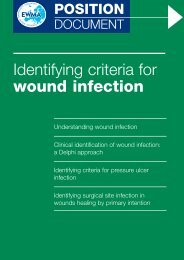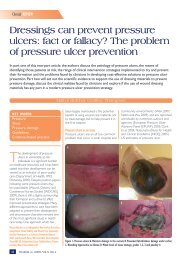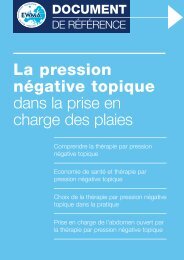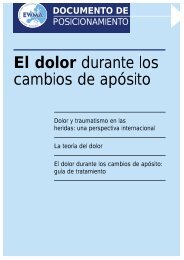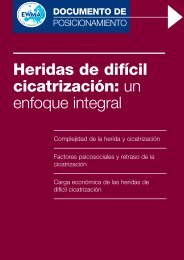VIEW PDF - Wounds UK
VIEW PDF - Wounds UK
VIEW PDF - Wounds UK
Create successful ePaper yourself
Turn your PDF publications into a flip-book with our unique Google optimized e-Paper software.
Clinical RESEARCH/AUDITMeasuring outcomes with complexpatients: an audit of the effect ofActiform Cool on painful woundsSarah Bradbury, Nicola Ivins, Keith Harding, Anna TurnerAbstractBackground: There is growing awareness surrounding the importance of wound pain, recognised by the publication ofrecent international studies (White, 2008). Wound pain has been identified as an outcome important to patients, inaddition to physiological endpoints. It can be difficult to use randomised controlled trials to measure subjective outcomessuch as pain, particularly with complex patients. An audit was therefore used to explore the effect of Actiform Coolon wound-related pain. Methods: Change in wound-related pain was assessed using a modified Short-Form McGill PainQuestionnaire pre- and post-application of Actiform Cool, and patients were asked to report on any changes in their painexperience, and the effects of this on their activities of daily living. Results: Results indicated that 12 patients reported anoverall decrease in pain levels following use of the dressing. Four patients reduced their analgesia requirements with onediscontinuing opiate analgesics. Five patients reported improvement in their sleep patterns and three reported improvedmobility. Conclusion: The overall outcome reinforces that Actiform Cool has the potential to reduce pain in some patientswhen used as part of a pain management plan. Conflict of interest: This audit was funded by Activa Healthcare Ltd.KEY WORDSOutcome measuresWound painActiform CoolComplex woundsOutcome measurement is arelatively new concept usedwithin healthcare as a meansof evaluating the efficacy of varioustreatments (Price, 1999; Steed et al,2006). Within the field of wound care,the focus traditionally has been on themeasurement of physiologic endpoints,such as speed of healing, percentagechange in wound dimensions, changesin exudate levels or rates of infection(Soon and Chen, 2004).Sarah Bradbury and Anna Turner are ResearchNurses; Nicola Ivins is Clinical Trials Coordinator,and Keith Harding is Professor of RehabilitationMedicine (Wound Healing), Department ofWound Healing, Cardiff University22 <strong>Wounds</strong> <strong>UK</strong>, 2008, Vol 4, No 3It is becoming more widelyrecognised that outcomes that areconsidered important to healthprofessionals, in terms of therationalisation of clinical decision makingand as part of clinical research, are notnecessarily those deemed important bypatients. The impact of factors that caninfluence the health-related quality of lifeof patients living with a chronic wound,such as changes in mobility and generalfunctioning and control of odour andpain, should be considered as equallyimportant in measuring the success ofwound care interventions.There is a growing awarenessamong clinicians about the significanceof wound pain as an outcome that isimportant to patients. Pain from chronicwounds can be extremely severe andhave a debilitating effect on a patient’sphysical and mental health. Problemswith mobility and disturbed sleep canlead to depression and social isolation(Benbow, 2006; Flanagan, 2006), andprevious experience of pain can furtherexacerbate pain and cause anxiety(Hollinworth, 1997). Several studies havefound that patients considered pain tobe the worst part of having a leg ulcer,and would often consider pain relief tobe more important than healing (Hylandand Thomson, 1994; Hofman et al, 1997;Husband, 2001).Understanding of the importance ofwound pain in terms of health-relatedquality of life and its physiological effecton wound healing itself has increased,and so more work on effectivemethods of minimising wound painand trauma is being performed. Thesheet hydrogel dressing, Actiform Cool(Activa Healthcare, Burton-on-Trent),has been identified as potentially havinga pain-relieving effect (Hampton, 2004;Young and Hampton, 2005). In viewof the impact that dressings can haveon procedural pain and surroundingskin, the research and developmentof dressings that have the potential toreduce this effect are significant andrequire further evaluation (Price, 2005).In terms of outcome measures,measuring the effect of an interventionlike the application of a wound dressing,on a so-called ‘soft’ measure like pain,can be problematic (Greenhalgh,2001). Difficulties arise when it comesto determining the best methods formeasuring these types of outcomes,especially with consideration to the
Clinical RESEARCH/AUDITincreasing number and complexity ofpatients being managed by woundcare specialists today. In terms of theestablished hierarchy of evidencethat is widely referred to in theliterature (Barton, 2000; Greenhalgh,2001), randomised controlled trials(RCTs) are considered to be the‘gold standard’ method of determiningclinical efficacy and providing validand reliable information regarding thetrue effect of various interventions(Price, 1999; Greenhalgh, 2001).The issue that presents itself whentrying to combine what some wouldconsider proven conventional researchmethods to measure outcomes withcomplex patients is that these patientsdo not necessarily fit into the strictinclusion/exclusion criteria defined byRCTs. These criteria often appear tolead to the requirement for an almost‘perfect’ wound or ‘perfect’ patientthat in reality is difficult to find. Whenthis is combined with the evaluationof a complex, personal and subjectiveexperience like wound pain, it is evidentthat the interpretation of the results ofan RCT may not necessarily reflect thetrue effect of any given interventionas was previously thought. The resultsof an RCT also do not always readilypromote the translation of research intopractice and, in the case of patients withcomplex wounds, do not necessarilyalways achieve their aim of strictlycontrolling bias due to a potential lackof external validity.These issues highlight the need forother approaches to be consideredwhen evaluating new treatmentsor interventions on patient-centredoutcomes for patients with complexwounds, even if these approachesare not deemed to deliver the bestevidence in terms of the traditionalhierarchy. While case series are oftenconsidered to be relatively weakscientific evidence, they can be usefultools for recording interesting cases andexploring subjective experiences from apatient’s perspective, while incorporatingsome more objective measures or tools(Greenhalgh, 2001; Peat et al, 2002).They can also be useful at bridging thegap between theory and practice asthey are easy for non-academic cliniciansto understand (Greenhalgh, 2001). AsGreenhalgh (2001) stated, evaluatingthe potential contribution of particularstudies to an overall evidence baseneeds to go beyond placing it into afixed hierarchy — thus, every study hasthe potential to provide evidence thatcan be combined with experience toguide clinical practice, and we should notnecessarily only consider changing ourpractice based on the statistical outcomeof certain methods.In view of this, and withacknowledgement of the complexityof the population of patients routinelyseen in clinics, an audit was conductedof the effect of Actiform Cool onwound-related pain, the results of whichwill be illustrated by descriptions ofcase studies. The use of an audit withassociated case series was considereda more appropriate approach in thiscase as it provided a more accuraterepresentation of the use of ActiformCool on patients with the types ofpainful complex wounds and associatedco-morbidities that are often met inthe clinical setting. This method alsoenabled patient views on a personal andsubjective experience to be obtained.MethodThe audit sample population was madeup of patients attending both complexwound clinics and community leg ulcerclinics over a six-month period. Anypatient with a painful wound suitable fortreatment with a sheet hydrogel dressingand who was willing to participate wasincluded. Demographic details andmedical history and current medicationswere collected. A full wound assessmentwas performed using the standardisedcriteria set out in the normal clinicwound assessment chart. This includedassessment of the wound bed, woundedge, surrounding skin, exudate levels andpresence of odour. Photographs and areameasurements were taken to monitorchanges in wound size and appearance assecondary outcome measures.The primary outcome measurewas change in wound-related pain andwas assessed using the Short-FormMcGill Pain Questionnaire (SF-MPQ)(Melzack, 1987). This assessment toolwas chosen as it is able to capture thenature as well as the intensity of painexperienced. The SF-MPQ is a generictool that has been shown to be bothvalid and reliable in several differentpatient populations (Seymour, 1982;Helme et al, 1989; Dudgeon et al, 1993;McDonald and Weiskopf, 2001), andhas been demonstrated to be easy foruse by patients (Melzack, 1987; Helmeet al, 1989). Although it has not beendirectly validated for use in patientswith wounds, it has been widely usedin studies within the wound care realm(Cullum and Roe, 1995; Noonan andBurge, 1998; Walters et al, 1999). The SF-MPQ incorporates 14 pain descriptorsassessing both sensory and affective paindimensions scored on a 4-point scalefrom 0 (None) to 3 (Severe). A 100mmVisual Analogue Scale (VAS) is includedto measure overall intensity. The SF-MPQ was administered before the initialapplication of Actiform Cool and oncompletion of the audit.Patients were also asked to reporton any changes in their experience ofpain and to comment if the pain hadany effect on their activities of dailyliving, such as sleep and mobility. Thiswas to again to elicit the views of thepatient’s experience and any effect onoutcomes that were important to themand impacted on their quality of life.Any changes to dosage and frequencyof analgesia used to control wound painwere also recorded.Actiform Cool was applied inconjunction with any previously usedtreatment, such as compressionbandaging. They were able to increaseor decrease their analgesia as requiredas the dressing was to be used as anadjunct to standard methods of paincontrol. Patients remained on the auditfor up to five weeks depending on theprogress of the wound, effect on painlevels and personal preference. Patientswere audited using Actiform Cool forup to four weeks. The final assessmentwas performed on the next routine clinicappointment, unless contactedby the patient with any concerns.Interim dressing changes wereperformed either by the patient orcommunity nursing team.<strong>Wounds</strong> <strong>UK</strong>, 2008, Vol 4, No 323
Pain intensity(0=none, 1=mild, 2=moderate, 3=severe)Clinical RESEARCH/AUDITwith some evidence of granulationtissue. Exudate levels were minimal, witherythema, oedema, eczema and drynessto the surrounding skin.A SF-MPQ was completed toassess his ulcer pain, and it was evidentfrom Mr L’s comments that this wasseverely affecting his quality of life. Hedescribed how the pain disturbed hissleep, and how his mobility was affectedas he was unable to put his foot fullyflat on the floor. His pain was poorlycontrolled with his current analgesia andhe described it as ‘feeling like a knife’.Mr L had been experiencing high painlevels in the ulcer since its recurrencefive months previously, and in previousulcerations over several years to thesame site. He had to rely on his wife forassistance with his daily activities andwith changing his dressings.Treatment outcomeMr L continued with his currenttreatment for a further week, at the endof which he stated that the pain wasstill affecting his mobility, describing it as‘biting, stinging and stabbing’. ActiformCool was applied along with modifiedcompression, with emollients and a mildsteroid ointment to treat eczema to thesurrounding skin.After two weeks, Mr L’s pain levelshad much improved. Figures 1 and 2indicate the changes in pain descriptorsand VAS scores recorded pre- andpost-Actiform Cool. Mr L requestedto continue with Actiform Cool as hisprimary dressing. Increased granulationtissue and more active wound edgeswere also observed in the ulcer itself,with a decrease in length to 8.1cm.However, as Mr L had been commencedon modified compression at the sametime as the Actiform Cool, these effectscould be attributed to the combinationof treatment, and not just the ActiformCool in isolation.Case study 2Clinical scenarioMrs C was a 71-year-old woman witha 10-year history of venous ulcerationto the left medial malleolus. Her onlymedication was regular co-codamol forulcer-related pain.Pre-Actiform CoolFigure 3. Changes in the VAS score pre and post-Actiform Cool in case study 2.ThrobbingShootingPre-Actiform CoolSharpCrampingGnawingHot-burningAchingClinical presentationMrs C presented to clinic with a painfululcer with a sloughy wound bed, minimalgranulation tissue and static woundedges. The ulcer measured 1.3 x 1.5cmwith a depth of 0.1cm. Exudate wasminimal, with erythema, dryness andeczema noted on the surrounding skin.The nature and intensity of the painexperienced by Mrs C was assessedusing the SF-MPQ, and she reportedthat ulcer pain disrupted her sleeppattern and mobility. She was unable togo out shopping on her own, despiteher analgesia. Dressing her woundand performing interventions wasdifficult due to the levels of pain sheexperienced.Post-Actiform CoolHeavyPain descriptorsPost-Actiform CoolTenderSplittingTiringFigure 4. Change in SF-MPQ Results Pre- and Post-Actiform Cool in case study 2.SickeningFearfulPunishing/cruelTreatment outcomeMrs C’s identified problem wasconstant severe pain in her ulcer whichadversely affected her sleep, mobilityand overall general well-being. She wascommenced on Actiform Cool dressingsand continued with her current Class IIcompression hosiery.When attending a community clinictwo weeks after commencing ActiformCool, Mrs C was experiencing less ulcerpain and only required analgesia to goto bed. She felt a lot brighter in herself,was sleeping better and stated it was the‘best week I’ve had in years’.After a further two weeks, MrsC was reviewed in the specialistI did this Pcool againIt was Pos<strong>Wounds</strong> <strong>UK</strong>, 2008, Vol 4, No 327
Clinical RESEARCH/AUDIToutpatient’s clinic for her finalassessment, by which point she wasno longer requiring analgesia andwas reporting no pain. Figures 3 and4 represent the overall changes inher SF-MPQ and VAS scores beforeand after using the dressing. Mrs Cwas able to go out for walks andcommented that Actiform Cool had‘made a world of difference to mylife. This dressing is marvellous’. Asignificant decrease in wound size wasobserved over the course of the audit,and Mrs C requested to stay on thedressing.Case study 3Clinical scenarioMrs H was a 71-year-old woman witha long-standing history of recurrentulceration to her feet and legs relatedto rheumatoid arthritis. The rheumatoidarthritis was being managed withazathioprine and prednisolone tablets.Mrs H had previously had arterial bypasssurgery to her right leg, and also sufferedwith heart disease and anaemia. Amonga large amount of other medication,she took modified release morphinesulphate tablets and paracetamol forgeneral pain relief.Clinical presentationMrs H presented to the outpatients’clinic with multiple ulcerations to herright and left medial malleoli, the gaiterregion of her right leg and a large ulcerto the dorsum of her left foot, whichwas noted to be particularly painful.This area measured 7.2 x 4.0cm with adepth of 0.3cm. The ulcer beds weresloughy and granulating, with staticwound edges. Surrounding skin waserythematous, oedematous and dryand flaky, with minimal to moderatelevels of exudate. Mrs H had acomplex history and had experiencedpain for many years.She was able to distinguish herulcer pain from the pain caused byher other disease. Mrs H completed aSF-MPQ which recorded severe painfor many descriptors, and she alsoadded stinging as another descriptor.The pain was affecting her sleep andmobility and she was unable to wearfootwear comfortably.Pre-Actiform CoolFigure 5. Change in VAS Score Pre- and Post- Actiform Cool in case study 3.Pain intensity(0=none, 1=mild, 2=moderate, 3=severe)ThrobbingShootingPre-Actiform CoolSharpCrampingGnawingHot-burningAchingTreatment outcomePain in the ulcer on the dorsumof her foot was identified as themain problem so it was decidedto apply Actiform Cool with theaim of reducing her ulcer pain.Due to Mrs H’s complex historyand co-morbidities, she regularlyattended clinic and so was monitoredmore frequently than other auditparticipants.Following one week of treatmentwith Actiform Cool, Mrs H reportedthat she felt the dressing had helpedwith her ulcer pain. She expressedthe pain as ‘sore’. The dressing wasbeing cut to the size of the wound toprevent maceration to the surroundingskin.Post-Actiform CoolHeavyPain descriptorsPost-Actiform CoolTenderSplittingTiringFigure 6. Change in SF-MPQ Results Pre- and Post- Actiform Cool in case study 3.SickeningFearfulPunishing/cruelOne week later, Mrs H felt the ulcerpain was much improved again, andstated her mobility was slightly improved.Her sleep remained disturbed, althoughshe felt this was not wholly related toher ulcer pain but also related to herrheumatoid arthritis generally.Mrs H stated on the final assessmentvisit that although she continued toexperience pain, overall the dressing haddefinitely helped, which is highlightedin Figures 5 and 6. The pain was alsobetter in the left leg where all theulcers were being treated with ActiformCool, compared to the right leg whichhad continued with non-adherentdressings. Of particular interest is thatMrs H reported that she was no longertaking her morphine tablets since using28 <strong>Wounds</strong> <strong>UK</strong>, 2008, Vol 4, No 3
Pain intensity(0=none, 1=mild, 2=moderate, 3=severe)Clinical RESEARCH/AUDITActiform Cool, and was now managingon paracetamol taken intermittently,which is a significant decrease in typeand frequency of analgesia.The dimensions of the ulcer tothe dorsum of the left foot remainedthe same, although the ulcer appearedslightly shallower and there was healthygranulation tissue evident at the base.Overall, the Actiform Cool dressingshad a very positive effect on Mrs H’spain experience, which was highlightedboth by her comments, the outcomes ofthe SF-MPQ pain assessments and thediscontinuation of morphine analgesia.Mrs H requested to continue with thedressings on completion of the audit.Case study 4Clinical scenarioMr J is a 55-year-old male with a threeyearhistory of venous ulceration. Dueto the pain in his ulcer he took regularibuprofen, in addition to a beta-blockerto treat hypertension.Clinical presentationMr J presented with a venous leg ulcerover the left medial malleolus. The ulcerhad developed initially from a traumaticinjury. On initial wound assessment,the wound bed was granulating withevidence of slough. The wound edge wasepithelialising with signs of erythema,oedema and haemosiderin staining tothe surrounding skin. Wound exudatelevels were minimal.An initial pain assessment using theSF-MPQ was performed, which indicatedthe wound pain was of moderateseverity but was tolerable with hisanalgesia. The pain from the ulcer did notaffect his sleep pattern or his activitiesof daily living. Mr J had to work full-timedespite being in pain from his ulcer.Treatment outcomeAfter two weeks of using ActiformCool as a primary dressing, assessmentscaptured an improvement in pain levels.Mr J commented that he had reducedhis analgesia and was now taking onlyone ibuprofen in the morning. Whenusing the SF-MPQ to describe theulcer-related pain, the severity was nowPre-Actiform CoolFigure 7. Change in VAS Score Pre- and Post- Actiform Cool in case study 4.ThrobbingShootingPre-Actiform CoolSharpCrampingGnawingHot-burningAchingreduced to mild. Figures 7 and 8 indicatethe reduction in pain levels recordedduring the audit period. The ulcer almosthealed during the audit period, andwent on to completely heal within a fewweeks of completion.DiscussionThe overall outcome of the auditreinforces the belief that ActiformCool has the potential to reducepain in some patients when used aspart of an overall pain managementtreatment plan. Although the dressingwas not successful in every case andthe results of the changes in pain levelsfrom the SF-MPQ were not statisticallysignificant, it was still considered asuccessful outcome by those patientswhose pain decreased. Although aPost-Actiform CoolHeavyPain descriptorsPost-Actiform CoolTenderSplittingTiringFigure 8. Change in SF-MPQ Results Pre- and Post-Actiform Cool in case study 4.SickeningFearfulPunishing/cruelvalidated pain assessment tool wasused, on occasions the results of thiswere not always consistent with thepatient’s self-reports, which makes theresults of an audit such as this difficultto fully interpret based on statisticalevidence alone. Consideration needs tobe given to the fact that many of thesepatients have both complex woundand general medical problems that caninfluence outcomes and make themdifficult to predict. It should also beacknowledged that other treatmentssuch as compression, which wereutilised alongside Actiform Cool, andthe short period of time over which thedressing was assessed, make it difficultto conclude that the use of ActiformCool was the only factor contributingto pain reduction.<strong>Wounds</strong> <strong>UK</strong>, 2008, Vol 4, No 329
Clinical RESEARCH/AUDITThe issues above may alsocontribute to the conclusion that itcannot be determined with any certaintyat present when Actiform Cool willprovide effective pain relief. For severalpatients included in the audit with verypainful wounds, multiple complex comorbiditiesand who were on varioustypes of analgesia, the application ofActiform Cool was of benefit for someand not others. The important pointthat should be acknowledged from theresults of this audit is that in the realworld of clinical practice, Actiform Coolcan improve the experience of painin patients with a variety of complexwounds, an outcome which may nothave been determined by the study ofstraightforward patients enrolled in anRCT.The resulting decrease in frequencyor dosage of analgesia for four patientswas also an important outcomeconsidering the reluctance of somepatients to take sufficient amountsof oral analgesia to control pain, anddue to the side-effects that may beexperienced. The patient that was ableto discontinue opiate analgesia wasespecially significant considering theside-effects of this type of medicationand with consideration to the fact thatshe suffered with severe rheumatoidarthritis. Although she still experiencedsome discomfort from this, her woundpain was markedly improved and shewas managing to control her pain withintermittent paracetamol only.The issue of wound pain and the useof dressings which have the potentialto reduce pain is definitely an areawhich merits further investigation. AsHollinworth (2005) stated it may not befeasible to completely eliminate woundrelatedpain in every patient, but it isusually possible to modify the pain apatient experiences. The use of ActiformCool dressings may be one such methodof achieving this. The management ofa patient’s pain may have the abilityto impact on healing rates throughareas such as improved sleep, decreasein physiological stress responses andin the ability to tolerate higher levelsKey Points8 Determining the success ofinterventions on measuressuch as pain and quality oflife is difficult with traditionaloutcomes using physiologicendpoints.8 Measuring outcomes usingconventional researchmethods is problematic forcomplex patients.8 Actiform Cool has thepotential to reduce woundpain for some complexpatients.8 Further research into topicaltreatments of painful woundsis required.30 <strong>Wounds</strong> <strong>UK</strong>, 2008, Vol 4, No 3
Clinical RESEARCH/AUDITof compression, as well as leading toimproved quality of life.It can be seen from the case studiespresented that it is not always possibleto predict outcomes with complexpatients. The audit results illustrate theimpact that a simple hydrogel dressingcan have on severe pain from complexulceration. According to traditionalevidence hierarchies, this would not beconsidered strong evidence on whichto change practice, yet it provokes thethought that sometimes considerationneeds to be given to simple treatmentsthat have been shown to be effective incertain cases.Healing is often considered to bea primary measure of success withinwound care, yet with an audit such asthis where healing was not a primaryendpoint, both the patient and cliniciansfelt that a successful outcome had beenachieved as pain levels had decreased,mobility or sleeping patterns hadimproved and an overall increase inquality of life was reported.ConclusionWound pain is often one of thesymptoms patients find particularlydistressing (Charles, 1995; Ebbeskogand Ekman, 2001), and studies suggestthe prevalence of pain in patientswith pure or mixed venous ulcers isapproximately 50% (Hofman et al, 1997;Nemeth et al, 2003). For 12 patientsin this audit, the use of Actiform Coolhad a significant impact on their painand its effect on their daily lives. Thisis an important outcome to considerfor clinical practice as this may provideanother ‘weapon in the armoury’ whenit comes to addressing the issue ofwound pain without reaching for theprescription pad. This is an increasinglyimportant consideration in terms ofproviding cost-effective treatment intoday’s economically challenged NHS, inaddition to trying to limit the side-effectsthat can be experienced by patients withcertain analgesics.The knowledge and informationavailable to clinicians at any one time isconstantly evolving due to an ongoingresearch process. The consequenceof reconsidering traditional outcomemeasures in wound care is that abroader view of what constitutes successneeds to be observed. Consensuson complex wound management isdifficult to achieve, especially consideringthe multiple factors that may affectindividual patients. The case reportsand overall audit results indicatethat statistical differences cannot beassumed as an absolute requirementfor changing clinical practice, as they donot necessarily imply clinical significances— flexibility and an acknowledgementof the reality of clinical practice needs tobe acknowledged when considering theimportance of outcome measures andtraditional views regarding hierarchies ofevidence. W<strong>UK</strong>ReferencesBarton S (2000) What clinical studiesprovide the best evidence? Br Med J 321:255–6Benbow M (2006) Holistic assessment ofpain and chronic wounds. J Comm Nurs20(5): 24–8Charles H (1995) The impact of leg ulcers onpatients’ quality of life. Prof Nurse 10: 571–4Cullem N, Roe B (1995) Leg Ulcers: NursingManagement: A Research-Based Guide. ScutariPress, HarrowDudgeon D, Raubertas RF, RosenthalSN (1993) The Short-Form McGill PainQuestionnaire in chronic cancer pain. J PainSymp Manag 8(4): 191–5Ebbeskog B, Ekman SL (2001) Elderlypersons experience of living with leg ulcers:living in a dialectal relationship betweenfreedom and imprisonment. Scandinavian JCaring Sciences 15(3): 235–43Flanagan M (2006) Managing chronic woundpain in primary care. Practice Nurse 31(2):34–7Greenhalgh T (2001) How to read a paper:The basics of evidence based medicine. BMJPublishing Group, LondonHampton S (2004) A small study in healingrates and symptom control using a newsheet hydrogel dressing. J Wound Care 13(4):297–300Helme RD, Katz B, Gibson S, Corran T(1989) Can psychometric tools be used toanalyse pain in a geriatric population? ClinExp Neurol 26: 113–7Hofman D, Ryan T, Arnold F, et al (1997)Pain in venous leg ulcers. J Wound Care 6:222–4Hollinworth H (1997) Wound care – lesspain, more gain. Nurs Times 93(46): 89–91Hollinworth H (2005) Pain at wounddressing-related procedures: a template forassessment.World Wide <strong>Wounds</strong> Available at:http://www.worldwidewounds.com/2005/august/Hollinworth/Framework-Assessing-Pain-Wound-Dressing-Related.html[Accessed 31 January 2008]Husband LL (2001) Venous ulceration:the pattern of pain and paradox. ClinEffectiveness Nurs 5: 35–40Hyland ME, Thomson B (1994) Quality oflife of leg ulcer patients: questionnaire andpreliminary findings. J Wound Care 3(6):294–8McDonald DD, Weiskopf CS (2001) Adultpatients’ postoperative pain descriptionsand responses to the Short-Form McGillPain Questionnaire. Clin Nurs Res 10:442–52Melzack R (1987) The short-form McGillPain Questionnaire. Pain 30: 191–7Nemeth KA, Harrison MB, Graham, ID,Burke S (2003) Pain in pure and mixedaetiology venous leg ulcers: a three phasepoint prevalence study. J Wound Care 12:336–40Noonan L, Burge S (1998) Venous leg ulcers:is pain a problem? Phlebology 13: 14–19Peat J, Mellis C, Williams K, Xuan W(2002) Health science research: a handbookof quantitative methods. Sage Publications,LondonPrice P (1999) The challenge of outcomemeasures in chronic wounds. J Wound Care 8(6): 306–8Price P (2005) An holistic approach towound pain in patients with chronic wounds.<strong>Wounds</strong> 17(3): 55–7Seymour RA (1982) The use of pain scales inassessing the efficacy of analgesics in postoperativedental pain. Eur J Clin Pharmacol23: 441–4Soon SL, Chen SC (2004) What are woundcare outcomes? <strong>Wounds</strong> 16(5): 150–63Steed DL, Hill DP, Woodske ME, PayneWG, Robson MC (2006) Wound-healingtrajectories as outcome measures of venousstasis ulcer treatment. Int Wound J 3: 40–47Walters SJ, Morrell CJ, Dixon S (1999)Measuring health-related quality of life inpatients with venous leg ulcers. Qual Life Res8: 327–36White R (2008) A multinational surveyof the assessment of pain when removingdressings. <strong>Wounds</strong> <strong>UK</strong> 4(1): 14–22Young SR, Hampton S (2005) Painmanagement in leg ulcers using ActiformCool. <strong>Wounds</strong> <strong>UK</strong> 1(3): 94–101<strong>Wounds</strong> <strong>UK</strong>, 2008, Vol 4, No 331




